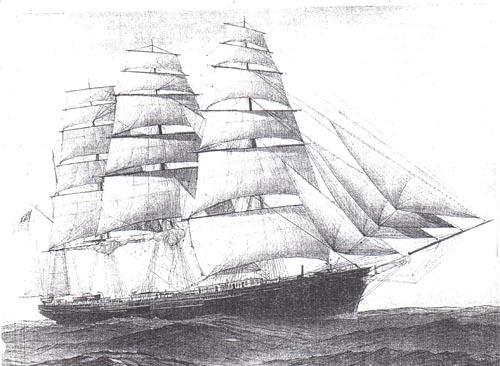 |
FAMOUS SHIPS |
 |
FAMOUS SHIPS |
The GREAT
REPUBLIC
Very
few ships can claim to be unique before they are even built.
THE GREAT REPUBLIC was one of those ships.
Donald KcKay indicated that he intended to build a vessel almost three
times the size of any ship afloat at the time at his own expense.
There were many profits of doom on both sides of the Atlantic who bet
that Donald McKay would loose his shirt on this deal.
She
was launched on October 4, 1853 amidst much excitement in Boston, were a public
holiday was declared in honor of the event and 60,000 people cheered the ship as
she went down the ways into her new element.
Longfellow even wrote a poem concerning the ship and it looked as though
she was going to indeed be the largest, fastest, finest sailing ship ever know.
 The
GREAT REPUBLIC had reached her first goal – she was BIG.
She was designed as a four masted barque.
Her dimensions were: Length, 335 feet; beam, 53 feet; depth, 38 feet.
Each of her four decks had 8 feet headroom clearance!
Her mainmast was 228 feet tall, with a main diameter of 44 inches.
Her main yard was 120 feet long with a diameter of 28 inches, with the
remaining yards and masts in proportion to the main yard.
Her total sail area was almost 16,000 yards.
Her main decoration consisted of two huge, carved and gilded eagles, one
at her stem and the other with wings outstretched across her stern-board.
The
GREAT REPUBLIC had reached her first goal – she was BIG.
She was designed as a four masted barque.
Her dimensions were: Length, 335 feet; beam, 53 feet; depth, 38 feet.
Each of her four decks had 8 feet headroom clearance!
Her mainmast was 228 feet tall, with a main diameter of 44 inches.
Her main yard was 120 feet long with a diameter of 28 inches, with the
remaining yards and masts in proportion to the main yard.
Her total sail area was almost 16,000 yards.
Her main decoration consisted of two huge, carved and gilded eagles, one
at her stem and the other with wings outstretched across her stern-board.
Unfortunately,
she was never to sail.
She was taken to New York and loaded in preparation for her maiden
voyage. She
had already earned some money, as before she went to New York she was opened to
the public – at a dime a head – to see this modern marvel.
On December 26th, 1853, fire broke out in a dockside bakery
and sparks from this fire ignited the rigging of the GREAT REPUBLIC.
The crew made heroic efforts to stop the fire from spreading down the
rigging and sails to the ship, but lost.
The yards and masts with blazing sails and rigging came crashing down
onto the hull, setting fire to the upper deck and the cargo below.
Two other ships were totally destroyed – The GREAT REPUBLIC suffered
terrible damage.
In order to save what they could, the ship was scuttled to avoid being
totally destroyed by fire.
Unfortunately, she was loaded with grain which became swollen by the
water trapped between decks and resulted in severely straining the hull.
This was a major financial disaster for Donald McKay.
Donald
McKay never attempted another ship of this magnitude.
He left the salvage of the ship to Captain Nathaniel Palmer, and sold the
resurrected giant to A A Low & Brother.
The ship finally sailed out of New York in 1855 under the command of
Captain Joseph Limeburner, but she was not the same ship as envisioned by Donald
McKay. She
had lost her top deck, her spars had been cut down, and her golden eagle on her
stern was gone.
But she went on to vindicate her conception with performances of which
any ship might justly be proud.
She
left New York on 24 February and arrived at Liverpool 13 days out.
Her detractors noted that she was so big she could not dock due to her
excessive draught, but that did not bother her captain.
He embarked 1,600 British soldiers for a passage to Marseilles, and then
went on the charter to the French government for the transport of troops to the
Crimea.
She
then returned to New York at the end of 1856 and began her years of fame in the
hazardous Cape Horn trade.
She was converted to a three skysail-yarder by the removal of her jigger
mast. She
then carried a massive 5,000 tons of general cargo on her first passage as a
Cape Horner, going from New York in December 1856 to San Francisco.
On the way down to the equator she ran 413 miles in one day, most of the
time making the astounding rate of over 19 knots!
If she had not been delayed in calms and fogs for five days, she may even
have beaten the record time set by the FLYING CLOUD.
Even so, and as heavily laden as she was, she reached San Francisco in 92
days.
Despite
this, The GREAT REPUBLIC was beset by problems throughout her life.
She was fortunate to have Captain Joseph Limeburner as her skipper – he
overcame all of the problems which beset his vessel.
Three more passages were made up until 1861, when the American Civil War
interrupted. As
she was owned primarily by Southerners, she was seized by the U.S. Government.
A. A. Low and Brother resolved this by buying out the Southerners who had
an interest in the ship and in February, 1862 she was put to work as a transport
of Union forces.
While serving the Union she was twice run aground, but suffered little
damage. This
was primarily due to the superb seamanship of Captain Limeburner.